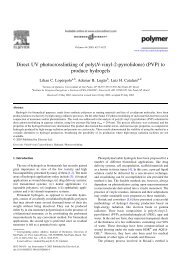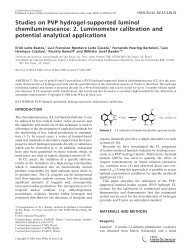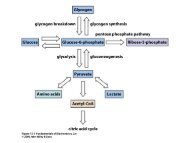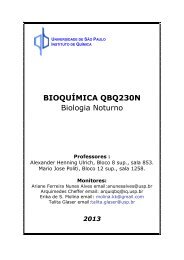The development of strategies for terpenoid structure determination
The development of strategies for terpenoid structure determination
The development of strategies for terpenoid structure determination
Create successful ePaper yourself
Turn your PDF publications into a flip-book with our unique Google optimized e-Paper software.
double bond <strong>of</strong> lanosterol 48 played an important role in the<strong>structure</strong> <strong>determination</strong> <strong>of</strong> this tri<strong>terpenoid</strong>.9 Sesquiterpenes with medium-sized rings<strong>The</strong> classical methods <strong>of</strong> <strong>structure</strong> <strong>determination</strong>, in whichdehydrogenation to aromatic hydrocarbons played a major role,were restricted to particular skeleta such as those based on anaphthalene or an azulene. <strong>The</strong> <strong>structure</strong> <strong>of</strong> the nine-memberedring <strong>of</strong> caryophyllene 49 was a matter <strong>of</strong> doubt <strong>for</strong> many years.Although caryophyllene had been known as a constituent <strong>of</strong>oil <strong>of</strong> cloves since 1834 and a crystalline nitrosite had beendescribed 66 in 1892, its <strong>structure</strong> was not finally establisheduntil the 1950’s. Oxidative degradation <strong>of</strong> caryophyllene 49af<strong>for</strong>ded three homologous cyclobutanedicarboxylic acids(e.g. 50) which were synthesized in 1936 67 thus establishing thepresence <strong>of</strong> the four membered ring. A suggestion 68 that caryophyllenecontained a nine-membered ring was based on theinfrared absorption <strong>of</strong> a nor-ketone derived from caryophylleneoxide. Definitive evidence <strong>for</strong> the <strong>structure</strong> <strong>of</strong> caryophyllenecame from the base-catalysed cyclization <strong>of</strong> this nor-ketone(kobusone 51) to a tricyclic hydroxyketone and its subsequentdegradation. 69 This was accompanied by studies on the acidcatalysedcyclization products <strong>of</strong> caryophyllene and caryophylleneoxide which gave compounds possessing the caryolane andclovane skeleta. An X-ray crystal <strong>structure</strong> <strong>of</strong> one <strong>of</strong> the cyclizationproducts, caryophanyl chloride, provided confirmatoryevidence <strong>for</strong> the <strong>structure</strong> <strong>of</strong> caryophyllene. 70ten-membered rings <strong>of</strong> the sesquiterpene lactones readily lentthemselves to this type <strong>of</strong> NMR study in which the contiguousrelationship <strong>of</strong> proton–proton spin systems could be unravelled.Hence many <strong>of</strong> their <strong>structure</strong>s were established in the1960’s.10 <strong>The</strong> impact <strong>of</strong> IR spectroscopy<strong>The</strong> elucidation <strong>of</strong> the <strong>structure</strong> <strong>of</strong> terpenes in the 1950’s madeuse <strong>of</strong> classical dehydrogenation and oxidative degradationaccompanied by interpretation <strong>of</strong> the IR spectra. <strong>The</strong> correlationbetween ring size and the frequency <strong>of</strong> the carbonylabsorption in the infrared spectrum played an important rolein the identification <strong>of</strong> the ring size <strong>of</strong> ketones, lactones, andcyclic anhydrides. 72 This is exemplified by the characterization<strong>of</strong> the functional groups <strong>of</strong> the plant hormone, gibberellicacid 54, 73 and by the studies on the di<strong>terpenoid</strong> fungal metaboliterosenonolactone 55 in which the presence <strong>of</strong> the γ-lactone(ν max 1786 cm 1 ) and the cyclohexanone (ν max 1724 cm 1 ) wereestablished 74 by infrared spectroscopy.<strong>The</strong> correlation between ring size and absorption was particularlyuseful in establishing the size <strong>of</strong> bridged rings. Thisis exemplified by structural work on α-cedrene 56 in whichthe size <strong>of</strong> the ring containing the double bond was in doubt.Oxidative cleavage <strong>of</strong> this ring gave a norcedrene dicarboxylicacid 57. This diacid was converted to an anhydride which hadthe infrared characteristics <strong>of</strong> a glutaric rather than a succinicanhydride. 75 This infrared study complemented the notalways reliable Blanc method <strong>of</strong> determining the ring size <strong>of</strong>anhydrides in which pyrolysis <strong>of</strong> glutaric anhydrides gavecyclopentanones whilst succinic anhydrides did not react. <strong>The</strong>infrared absorption <strong>of</strong> the ring D ketones derived from thetetracyclic di<strong>terpenoid</strong>s <strong>of</strong> the gibberellin and kaurene seriescharacterized them as cyclopentanones. 73,76<strong>The</strong> propensity <strong>of</strong> many medium-sized rings to undergocyclization reactions provided the basis <strong>for</strong> <strong>strategies</strong> <strong>for</strong> theelucidation <strong>of</strong> the <strong>structure</strong>s <strong>of</strong> other families <strong>of</strong> <strong>terpenoid</strong>natural product. This is exemplified by the ten-memberedring <strong>of</strong> the germacranolide lactones such as pyrethrosin. 71 Acidcatalysed cyclization <strong>of</strong> pyrethrosin 52 gave a decalin 53 whichwas correlated with ψ-santonin. However it was not until theadvent <strong>of</strong> NMR spectroscopy that many other <strong>structure</strong>s <strong>of</strong>this type were elucidated.Whereas the existence <strong>of</strong> quaternary centres at ringjunctions provided a stabilizing feature as far as chemicaldegradation was concerned leading to the identification <strong>of</strong>alkylcyclopentane and cyclohexane fragments, the presence<strong>of</strong> a quaternary methyl group <strong>of</strong>ten provided a block toestablishing connectivities between protons by NMR spindecoupling studies. On the other hand the highly functionalized11 <strong>The</strong> <strong>determination</strong> <strong>of</strong> relative stereochemistry<strong>The</strong> problems associated with establishing the relative stereochemistry<strong>of</strong> the <strong>terpenoid</strong>s can be divided into those relating tothe stereochemistry <strong>of</strong> the substituents and those associatedwith the stereochemistry <strong>of</strong> the ring junctions. Many <strong>of</strong> theclassical pre-spectroscopic <strong>strategies</strong> yielded results in the1940’s and 1950’s.<strong>The</strong> assignment <strong>of</strong> the stereochemistry <strong>of</strong> the menthols 58utilized 77 the comparative rates <strong>of</strong> their esterification withp-nitrobenzoyl chloride to determine the configuration <strong>of</strong> thealcohols at C-3. <strong>The</strong> two neomenthols were esterified moreslowly than either menthol or isomenthol. This was attributedto steric hindrance by the isopropyl group and hence this groupwas placed cis to the hydroxy in the neomenthols. <strong>The</strong> muchslower rate <strong>of</strong> hydrolysis <strong>of</strong> methyl podocarpate 59 comparedto methyl dehydroabietate 60 was used 78 to reveal the greatersteric hindrance in the <strong>for</strong>mer arising from interactions with themethyl group at C-10. <strong>The</strong> ester is an axial substituent in methylpodocarpate.Nat. Prod. Rep., 2001, 18, 607–617 611





![PE]+ + N. Fragmentação por clivagem sigma](https://img.yumpu.com/50134385/1/180x260/pe-n-fragmentaaao-por-clivagem-sigma.jpg?quality=85)










